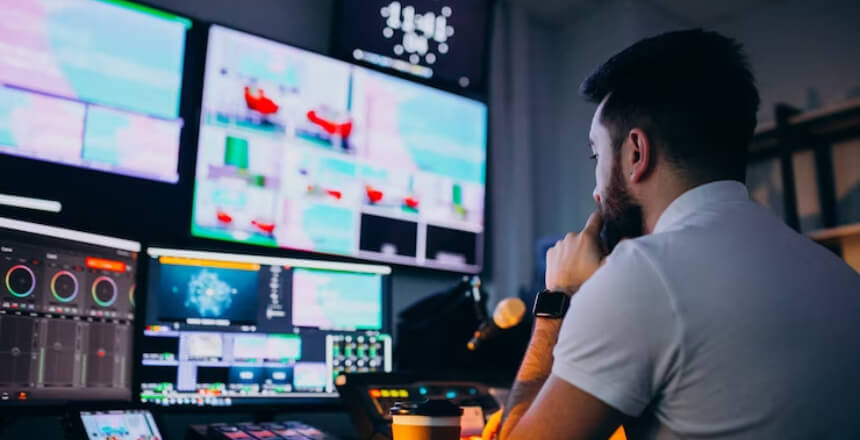Creating and editing videos is no longer a craft reserved for professionals with expensive equipment and software. The digital age has democratized this form of expression, allowing anyone with a smartphone and a computer to become a filmmaker.
But while the barrier to entry is lower, the art of making and editing videos still requires skill and understanding.
Whether you’re looking to create a memorable family montage, a persuasive business presentation, or the next viral YouTube sensation, here are some tips to help you perfectly make and edit your videos.
Choose The Right Software
Starting on the right foot means selecting the right video editing software that suits your skill level and needs. For Mac users, iMovie is a popular choice due to its user-friendly interface and robust features. But what if you’re a Windows user looking for something similar?
When it comes to iMovie for Windows, there are numerous alternatives like Movavi Video Editor, Adobe Premiere Elements or DaVinci Resolve that provide a similar experience.
These programs offer a range of tools from basic cutting and splicing to more advanced color correction and audio editing. Choose software that balances complexity with usability – it’s no use having a tool with all the bells and whistles if it’s too complex for you to use effectively.
For instance, Peter McKinnon, a renowned photographer and videographer, showcases his proficiency in Adobe Premiere Pro through his engaging tutorial videos.
McKinnon’s use of Adobe demonstrates how the right tool can streamline workflow, whether you’re a Mac or Windows user, and significantly improve the production value of content.
Understand Your Story
Before you even begin filming, it’s crucial to plan and understand the story you’re trying to tell. Are you aiming for an informative and straightforward tutorial, a gripping narrative, or just a fun and spontaneous vlog?
Structuring your content with a clear beginning, middle, and end will not only help you during filming but also during the editing process. This ensures that your video flows logically and keeps the viewer engaged. It’s not about having the most footage but having the right footage that drives your narrative forward.
An integral part of this process is screenwriting. Even if you’re not crafting a Hollywood film, a good script can serve as a blueprint for your video. It helps you keep track of your story, plan your shots, and ensure that your message is conveyed clearly.
Tools like Celtx, Final Draft, and WriterDuet offer user-friendly interfaces for crafting scripts, allowing you to focus on the creative aspect of your narrative. They provide features such as formatting assistance, storyboarding options, and collaboration capabilities, making them invaluable for both solo creators and teams.
By utilizing these screenwriting tools, you ensure that your story has a strong foundation before you even turn on the camera.
Consider the documentary “13th” by Ava DuVernay. The film, which explores the intersection of race, justice, and mass incarceration in the United States, follows a compelling narrative structure. By using a script that weaves historical facts with personal stories, DuVernay creates a powerful narrative that engages and educates the audience.
Capture High-Quality Footage
The adage ‘garbage in, garbage out’ is especially true in video editing. Ensure that you capture the highest quality footage possible. This doesn’t necessarily mean investing in high-end cameras, as many smartphones are capable of recording in HD or even 4K.
Pay attention to lighting, use a tripod or a stabilizer to avoid shaky footage, and be mindful of your audio – use an external microphone whenever possible. The better the raw material, the easier and more effective your editing will be.
For example, the high-quality footage captured for the “Planet Earth” series by the BBC is a testament to the importance of quality in visual storytelling. The series employed ultra-high-definition cameras, even in the most challenging environments, providing viewers with an unprecedented look at nature.
This dedication to capturing the best possible footage results in a more immersive experience, drawing viewers into the natural world the series depicts.
Learn The Basics Of Composition
Understanding the basics of composition, such as the rule of thirds, helps in creating visually appealing videos. This rule involves dividing your frame into nine equal segments with two vertical and two horizontal lines.
Place your subject along these lines or at their intersections for a more balanced and interesting shot. Good composition keeps your audience focused and can make even static shots engaging.
For instance, composition played a key role in the success of the viral video “Yes Theory: Throwing a Dart at a Map and Flying Wherever it Lands!” This video utilized the rule of thirds expertly to keep the shots dynamic and engaging, which is essential for maintaining viewer interest in a vlog-style format.
Their skillful composition keeps the focus on the hosts and their spontaneous journey, despite the unpredictability of the content.
Master The Art Of Editing
Editing is where the magic happens. Start by assembling your footage in the order that best tells your story. Trim the fat by cutting out unnecessary parts, keeping only what adds value to your narrative.
Pay attention to the pacing and rhythm of your video – too fast and you’ll overwhelm your viewers, too slow and you’ll bore them. Use transitions sparingly; often a simple cut is the most effective way to move from one scene to another.
As an example, consider the editing mastery in the music video for Childish Gambino’s “This is America”, which demonstrates the impact of precise editing.
Quick cuts and transitions between chaotic and calm scenes are timed impeccably to the music, adding layers of meaning to the video’s commentary on American culture. This shows how effective editing not only enhances visual storytelling but also deepens the narrative.
Enhance With Music And Sound Effects
Music and sound effects can greatly enhance the emotion and impact of your video. However, it’s important to choose tracks that complement the footage without overpowering it. If dialogue is important, make sure your music isn’t drowning it out.
Additionally, be mindful of copyright laws – only use music and sounds you have the right to use, whether it’s through purchasing royalty-free tracks or using ones that are free for public use.
The power of music to boost storytelling can be seen in the indie film “Drive,” starring Ryan Gosling. The film’s retro-synth soundtrack and meticulously chosen sound effects complement the neo-noir aesthetic, elevating the tension and emotion of the narrative without overwhelming the viewers or the on-screen dialogue.
Color Correction And Grading
Color correction and grading are the icing on the cake. They help in maintaining consistency throughout your video and can also set the mood. Whether you’re going for a warm, nostalgic feel or a cold, bleak look, adjusting the colors can make a world of difference.
This step can be quite technical, but even basic adjustments like correcting white balance or boosting saturation can significantly improve the visual appeal of your video.
For instance, “Mad Max: Fury Road” showcases the power of color correction and grading. The film’s distinct look, achieved through elaborate color grading, helped convey the harshness of the dystopian world and the intensity of the action.
The deliberate use of color enhances the thematic elements of the film and demonstrates how technical post-production work can significantly contribute to the story’s atmosphere and tone.
Conclusion
In the realm of video creation and editing, there’s a delicate balance between technology and creativity. With the right tools, a clear vision, and a good understanding of the basics, anyone can produce a video that looks professional and tells a compelling story. Remember, perfection is subjective and often comes with experience. So, keep practicing, experimenting, and learning with every video you make and edit. With these tips in mind, you’re well on your way to perfectly crafting your video narratives, one frame at a time.









